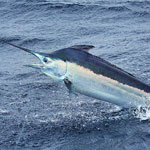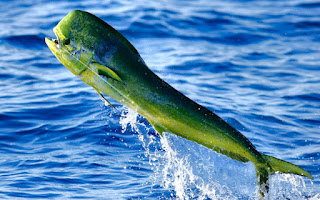COSTA RICA FISH SPECIES
 Marlin
Marlin
Caught every month of the year, with mid-November to early March exceptional, then slowing a bit from April into early June when it picks up again, peaking in August and September.
Sailfish Caught throughout the year, with May through August normally the top season. They may begin to thin out in September and the slowest months are from late August through November. Perhaps the most acrobatic of all blue water fish, the sailfish has engraved Costa Rica on every international angler wish list.
The beautiful fish, spending more time in the air than in the water during the fight is not as powerful as the marlin, but always spectacular. Double and triple hookups are not uncommon. More fish species in Costa Rica Read here
Tuna Peak months are probably August through October, but when all else fails, there are always tuna, any time of the year you want to look for them, and more often than not when you'd just as soon avoid them to concentrate on billfish.
The yellowfin and some bigeye tuna are often found well inside the Santa Catalina Islands, 30 minutes or less running time from the beach, while schools of 12 to 20 pounders are usually abundant on the outside. You frequently find concentrations of 40 to 60-pound tuna, and there are plenty of the 200 to 400 pounders caught every year. For more Fishing in Costa Rica visit https://costaricaviptransfers.com/tours/sport-fishing-tours/
Dorado Also known as dolphinfish or mahi-mahi, the dorado is one of the most exciting fish to catch on light tackle.
An extremely colorful fish, dorados are extremely fast swimmers. A hooked dorado might leap or tail walk, first in one direction, then another.
It's been estimated that they can reach speeds of 50 mph in short bursts. Look for them under trash lines that accumulate during the rainy season (roughly May to December).
Schools of dorado can become a nuisance for anglers looking for the larger billfish lurking below the school. The dorado is a delicious food fish.
Wahoo The first showing begins about the time the rains start in May, peaking in July and August. Most are caught around the rocky points and islands, but you will pick one up occasionally fishing offshore.
The wahoo is a loner and when traveling with another wahoo it's usually only a school of five or six. The fish can be found anywhere in the ocean but does seem to concentrate during the summer off of Costa Rica's Pacific coast. Considered a relatively rare species, the wahoo is usually caught while the angler is looking for other oceanic species.
That's always a nice surprise because many fishermen consider the wahoo one of salt water's finest delicacies. Experts speculate that the wahoo is the fastest fish in the ocean and it's no wonder that the first scorching run can burn out the drag on some reels.
Roosterfish Available all year, but there are more caught in the Papagayo Bay area from November through March. The roosters like the structure of the shoreline and islands where they're found in 50 to 60 feet of water.
The dorsal fin with its fanlike array gives the fish its name. It's an inshore species, often found in the surf, over sandy bottoms and always in moderate depths. The all-tackle world record is 114 pounds caught off of Baja, Mexico but many international anglers speculate that the conditions are right for the next record to come from Costa Rica.
An aggressive predator, the roosterfish is always exciting when hooked. There is no particular season for roosters so expect a hard hit anytime when fishing near shore and around rocks or islands.
SNAPPER (Pacific Coast) There are many species of snapper. Each fish is a shallow water fish preferring a rocky bottom structure that provides baitfish and protection. The cube is the largest of the snappers, often going beyond 100 pounds.
The dog snapper is the largest of the Pacific snappers with the world record of 78 pounds held by a resort in Costa Rica. Each species will be a tough fighter, particularly on light tackle and although all snapper is delicious eating the flesh of the larger fish can become course.


Comentarios
Publicar un comentario